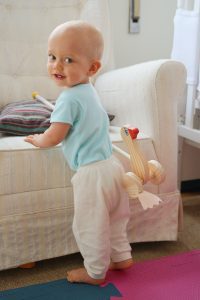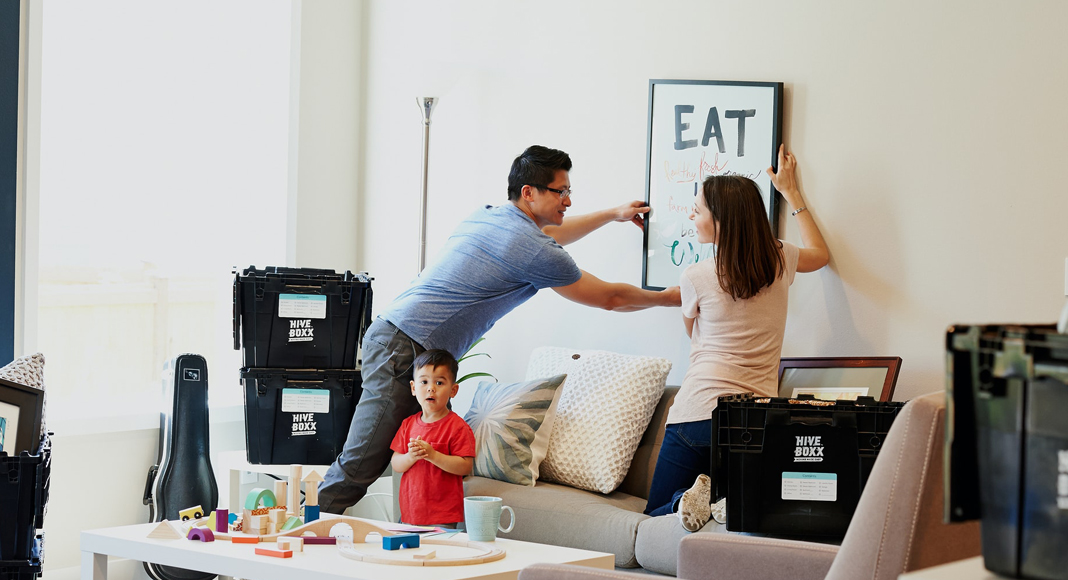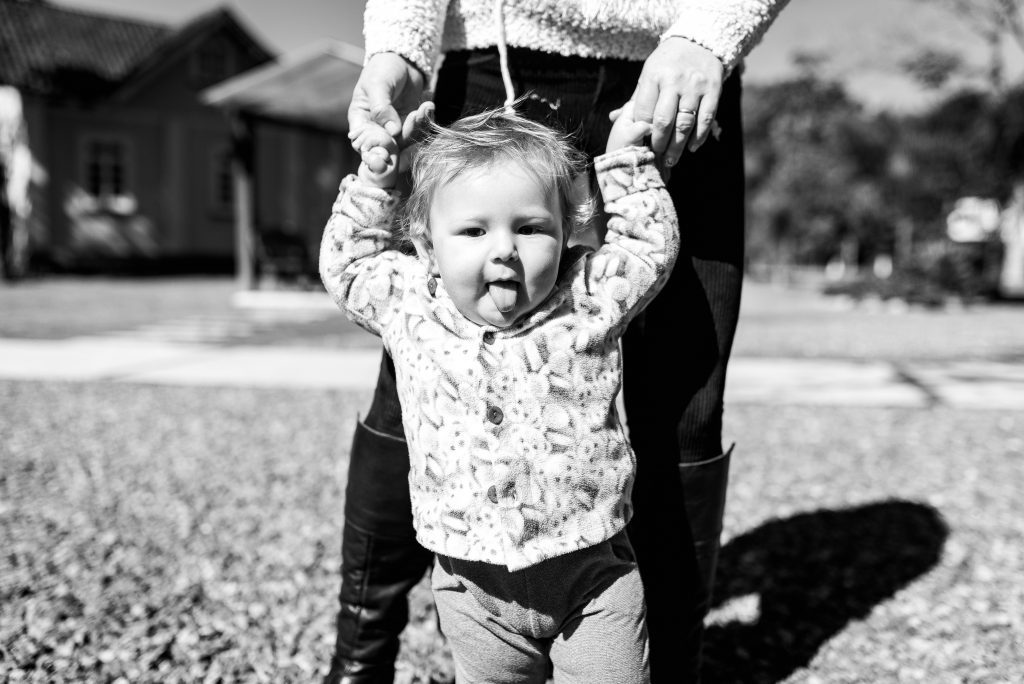 One of the biggest milestones that parents eagerly await is when our babies take their first steps. It’s this momentous, picture-worthy moment that very quickly reminds us we need to do more babyproofing! But for some babies, mine included, it seems that this milestone is happening later than expected.
One of the biggest milestones that parents eagerly await is when our babies take their first steps. It’s this momentous, picture-worthy moment that very quickly reminds us we need to do more babyproofing! But for some babies, mine included, it seems that this milestone is happening later than expected.
So how do we know if our child is delayed at walking?
According to one of EIRMC’s Pediatric Physical Therapists, Briana Ulanowski Smyer, DPT, PT, the current age range for children to begin walking is anywhere between 9 and 18 months! That is a huge range for such a highly anticipated event. Some children might even take longer than 18 months to walk. As long as they are progressively meeting their milestones, in order, even delayed walking is still just fine.
So what are the milestones?
In order for your baby to achieve this feat, they will need to meet certain milestones to develop their reflexes, balance, strength, and coordination.
 First, your child should begin lifting their head and rolling over on both sides. This can be developed through “tummy time” and is usually mastered around 4-6 months. Children should be able to roll over on both sides. If they aren’t, this is a cause for concern and may need to be addressed.
First, your child should begin lifting their head and rolling over on both sides. This can be developed through “tummy time” and is usually mastered around 4-6 months. Children should be able to roll over on both sides. If they aren’t, this is a cause for concern and may need to be addressed.
Next, your child should be able to sit up with support around 3-4 months old. This will help develop the muscles that will enable them to sit up without support around 6-9 months. You can help develop this skill by sitting them up in your lap, in a stroller, or in a supported seat. You can also help them sit up by supporting them against you while they sit on the floor and play with toys.
 Next comes another fun milestone! Crawling. Babies crawl in many different ways, but once your baby starts scooting around, they will continue developing the muscles necessary for those first big steps. Crawling is important for overall development. It is linked to proper brain development as well as enhancing the balance system, sensory system, coordination, and strength. Crawling happens around the 9-month mark but can vary depending on the child. You can help your child to crawl by motivating them with toys and putting them onto their tummy where they will begin to posture up and rock back and forth.
Next comes another fun milestone! Crawling. Babies crawl in many different ways, but once your baby starts scooting around, they will continue developing the muscles necessary for those first big steps. Crawling is important for overall development. It is linked to proper brain development as well as enhancing the balance system, sensory system, coordination, and strength. Crawling happens around the 9-month mark but can vary depending on the child. You can help your child to crawl by motivating them with toys and putting them onto their tummy where they will begin to posture up and rock back and forth.
 Babies will then begin pulling themselves up and standing alongside furniture, and even cruising! Cruising is when babies walk along with the furniture. This is a big sign that your child will begin walking independently soon! Watch for them pulling to stand, cruising along surfaces, taking steps with handheld assistance, and standing on their own for short periods of time. All of these skills can happen anywhere from 8 to 18 months.
Babies will then begin pulling themselves up and standing alongside furniture, and even cruising! Cruising is when babies walk along with the furniture. This is a big sign that your child will begin walking independently soon! Watch for them pulling to stand, cruising along surfaces, taking steps with handheld assistance, and standing on their own for short periods of time. All of these skills can happen anywhere from 8 to 18 months.
You can help your baby with these skills by putting toys on top of surfaces that your baby can reach once they are standing. While they are beginning to learn these skills, support their trunk and then slowly lower the amount of support you give them.
 Place toys in their hand while they are standing so that they begin to develop balance. Once they are standing, move their toy to the floor so that they can practice lowering and squatting to retrieve the toy. When holding their hands as they walk, wiggle their hand to give them a challenge. Stand your child against furniture and then encourage them to come to you just a few steps away.
Place toys in their hand while they are standing so that they begin to develop balance. Once they are standing, move their toy to the floor so that they can practice lowering and squatting to retrieve the toy. When holding their hands as they walk, wiggle their hand to give them a challenge. Stand your child against furniture and then encourage them to come to you just a few steps away.
Soon, they will be walking, and you’ll be reminiscent of the days when they weren’t quite so mobile.
 But, if 15-18 months comes and goes, and your child still isn’t walking or their skills have plateaued, it may be time to consult a physical therapist. EIRMC has outpatient therapy services with trained physical therapists who specialize in helping your child meet these physical milestones. Ask your child’s primary doctor for a referral to EIRMC’s Pediatric Physical Therapists. You can also contact EIRMC’s Pediatric Therapy office directly at (208) 529-7982.
But, if 15-18 months comes and goes, and your child still isn’t walking or their skills have plateaued, it may be time to consult a physical therapist. EIRMC has outpatient therapy services with trained physical therapists who specialize in helping your child meet these physical milestones. Ask your child’s primary doctor for a referral to EIRMC’s Pediatric Physical Therapists. You can also contact EIRMC’s Pediatric Therapy office directly at (208) 529-7982.
After an hour-long evaluation, the specialist will determine your child’s needs and help work with your child to develop these skills. Therapies take around 30-45 minutes and the therapists work with your child to develop balance, coordination, reflexes, and strength. Parents are heavily involved in the therapy process. Physical therapists will teach you different ways to assist your child at home, as well as what to watch for. Children are usually in therapy for just a short amount of time before they master the necessary skills.
There are a few reasons why your child may be delayed in walking. First and foremost, therapists are seeing a rise in what they call “container babies”, or children who are always in swings, slings, car seats, bumbos, etc. These children miss opportunities to develop strength, balance, and coordination. Give your children time to play on the floor so that they can bring their feet to their mouth, practice rolling over, and scoot to toys. This is not possible if they are always in a carrier.
 Another reason your child might be a delayed walker is their birth order. Youngest children aren’t as motivated to walk because their older siblings can be too helpful. Provide your child with quiet time to play where older siblings won’t interfere. Premature birth is another reason your child might not be hitting their walking milestones. Early babies should be held against their adjusted age when identifying milestone growth.
Another reason your child might be a delayed walker is their birth order. Youngest children aren’t as motivated to walk because their older siblings can be too helpful. Provide your child with quiet time to play where older siblings won’t interfere. Premature birth is another reason your child might not be hitting their walking milestones. Early babies should be held against their adjusted age when identifying milestone growth.
There are also underlying causes that can be a factor in late walking development such as physical disorders or an unknown injury. Neurological issues can also affect walking development. Uneven muscle tone, lack of symmetry in gross motor skills, and stiffness or floppiness can all contribute to late walking.
No matter the reason for delayed walking, the experts at EIRMC’s Pediatric Physical Therapies can help. While your picture-perfect moment may come later than you anticipated, it is just around the corner with the help of these specialists.













